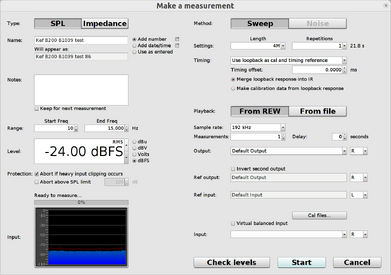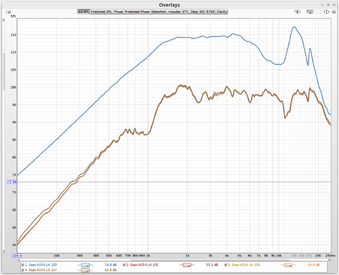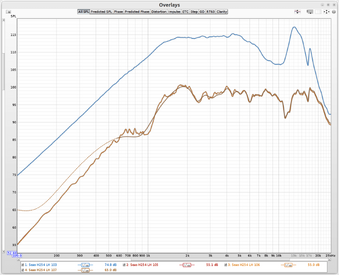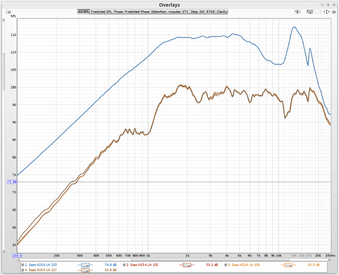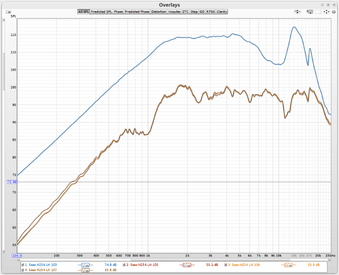Giallograle
Registered
Thread Starter
- Joined
- Nov 13, 2023
- Posts
- 4
More
- Preamp, Processor or Receiver
- Pass Labs XP-12
- Main Amp
- Roksan Caspian M1
- DAC
- Motu-M2
- Universal / Blu-ray / CD Player
- Roksan Caspian
- Front Speakers
- Roksan Darius
I've recently started using REW to measure the frequency response of a couple of drivers. It's a very powerful tool, so I've followed a couple of guides to get settings right, and played around with them when they didn't seem to be working well. However I'd appreciate if any other users could take a look and let me know if these settings look ok for my purposes.
I'm measuring the frequency, phase responses and impedance of a pair of Seas H254 tweeters and Kef B200 SP1039 mid/bass units in my Roksan Darius speakers in order to set the parameters for an active crossover.
I'm running REW V5.20.13 in Ubuntu on my Macbook. For measuring, I have a Line Audio Omni1 microphone, a Motu M2 USB interface and phantom power supply (one tip - I had to set PulseAudio to ignore the Motu to keep a working connection), and I built a loopback connection.
I set and calibrated the microphone input by a process of trial and error to minimise noise, and with my multimeter for exact levels, as the Motu has separate level controls for left and right inputs and headphone out which I used to power the speakers. I run the laptop on its battery when measuring to minimise mains noise. I'm measuring near field response from as close as I can get, around 5mm to the centres of the drivers; REW estimates about 30mm compared to the loopback signal.
Repeated runs with my latest settings give consistent results.
After adjusting the windows, I measured the B200s with a left width of 5.0ms, and a right width of 100ms. The Seas H254s with a left width of 2.0ms and a right width of 50ms. I also used the 'Estimate IR delay' function in Controls to correct the measurements.
Both drivers show quite large dips then rises (see final image); the B200 from 1750Hz to a peak around 3.5kHz, which corresponds to a jump in their impedance probably a result of a standing wave across the cabinet. Kef specify a 25-3,500Hz response. The Seas is supposed to have a 3-25kHz response, but has a 7db dip at 9.5kHz, and after a +3db peak at 13.3k rolls off rapidly; by 17k it's also down 7db and by 20k it's down 12db.
These are not current units although they've been replaced in the last ten years, however I'm wondering whether the results I'm measuring are correct, or whether the dips could be an artefact of my settings? Be grateful if anyone has any thoughts on this.
TIA
John


Impulse responses - I set the windows to include all of the 'noise' from the initial rise:


Frequency responses of all four drivers look closely aligned:

I'm measuring the frequency, phase responses and impedance of a pair of Seas H254 tweeters and Kef B200 SP1039 mid/bass units in my Roksan Darius speakers in order to set the parameters for an active crossover.
I'm running REW V5.20.13 in Ubuntu on my Macbook. For measuring, I have a Line Audio Omni1 microphone, a Motu M2 USB interface and phantom power supply (one tip - I had to set PulseAudio to ignore the Motu to keep a working connection), and I built a loopback connection.
I set and calibrated the microphone input by a process of trial and error to minimise noise, and with my multimeter for exact levels, as the Motu has separate level controls for left and right inputs and headphone out which I used to power the speakers. I run the laptop on its battery when measuring to minimise mains noise. I'm measuring near field response from as close as I can get, around 5mm to the centres of the drivers; REW estimates about 30mm compared to the loopback signal.
Repeated runs with my latest settings give consistent results.
After adjusting the windows, I measured the B200s with a left width of 5.0ms, and a right width of 100ms. The Seas H254s with a left width of 2.0ms and a right width of 50ms. I also used the 'Estimate IR delay' function in Controls to correct the measurements.
Both drivers show quite large dips then rises (see final image); the B200 from 1750Hz to a peak around 3.5kHz, which corresponds to a jump in their impedance probably a result of a standing wave across the cabinet. Kef specify a 25-3,500Hz response. The Seas is supposed to have a 3-25kHz response, but has a 7db dip at 9.5kHz, and after a +3db peak at 13.3k rolls off rapidly; by 17k it's also down 7db and by 20k it's down 12db.
These are not current units although they've been replaced in the last ten years, however I'm wondering whether the results I'm measuring are correct, or whether the dips could be an artefact of my settings? Be grateful if anyone has any thoughts on this.
TIA
John
Impulse responses - I set the windows to include all of the 'noise' from the initial rise:
Frequency responses of all four drivers look closely aligned:
Attachments
Last edited:








